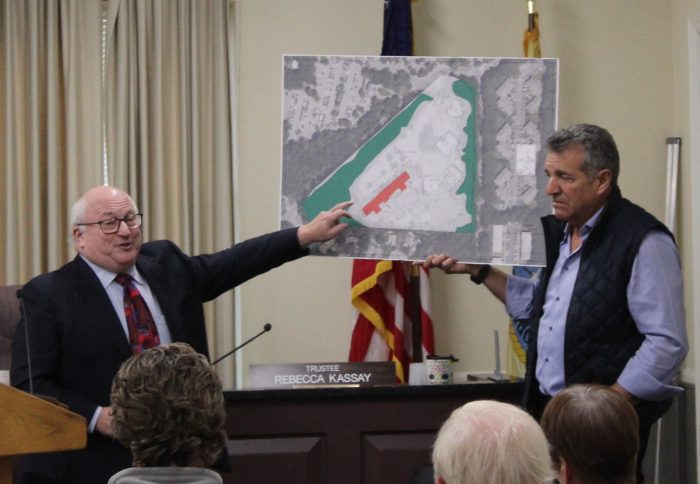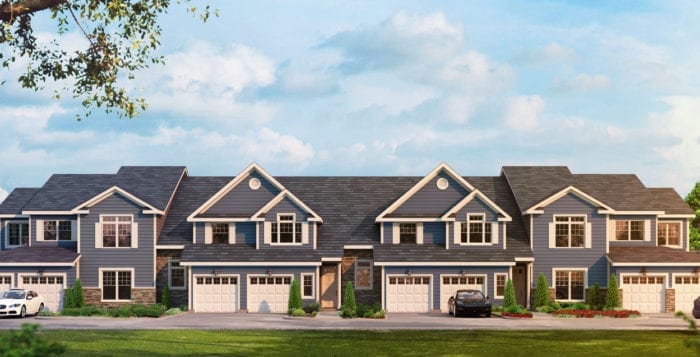Ten minutes before 6 p.m., every chair in the house was already taken. Behind the gallery, some sat on tables, others on desks. A standing crowd began to form. Younger attendees yielded their seats to their elder counterparts. All were in for a long night.
The board room at Village Hall could not contain the audience gathered on Monday night, May 1, for the Village of Port Jefferson Board of Trustees public hearing on the Maryhaven Center of Hope property on Myrtle Avenue.
“It’s great to see a full room,” said Mayor Margot Garant. “That means this community is engaged.”
The village board is considering modifying the zoning code and proposing an incentives package to encourage the historic preservation and adaptive reuse of historic buildings and structures.
The Maryhaven property is currently zoned as a Professional Office P-O District. Under the existing zoning code, an applicant within the P-O District can request a special-use permit for Moderate-Density Residence R-M District development.
Village attorney Brian Egan explained the motivations guiding these potential code changes.
The Maryhaven “building is certainly worth keeping,” he told the sea of residents in attendance.
Convincing the owners of that building to preserve it, however, represents a quandary for village officials. The existing zoning code lacks a mechanism to sway developers toward historic preservation.
“There is no obligation to save that building,” Egan said.
The proposed code amendment would create such a mechanism — a special permit application. Egan referred to this application process as “another layer of control” for the village board, enabling it to designate specific parcels that contribute to the village’s architectural or aesthetic character.
If a parcel meets these criteria, determined by the Board of Trustees, then the applicant would qualify for “slightly relaxed standards” under the R-M code, Egan stated.
In the previous week’s work session, they agreed those relaxed standards would be allowances for additional height and stories but no additional clearing — a tradeoff of density for historical preservation and conservation.
Developers from the Jericho-based Beechwood Organization, the firm negotiating with Catholic Health to acquire the Maryhaven property, attended the public hearing. Michael Dubb, principal at Beechwood, stated his intention to preserve the historic building on-site.
“It would be easier for me as the developer to knock that building down … but that wouldn’t be the right thing to do,” he said.
Richard Rosenberg, an attorney for Beechwood, expanded upon the firm’s vision for the site.
“The intention is to keep the original part of the structure, which is around 40-45,000 square feet, demolish the rest,” he said. “There is asbestos, there is lead-based paint. We have to clean it up according to regulations.” He added, “It’s a big ticket item.”
Public input
Following the presentations by Egan and Beechwood, the board took comments from the public. During that period, community members expressed a recurring message:
“I think the big problem that many of us have is density,” resident Eric Sackstein told board members. This general sentiment echoed throughout the evening.
Former village trustee Virginia Capon, who had chaired the Comprehensive Plan Committee, expressed her appreciation for the board in its willingness to preserve the historic structure.
But she objected to the board’s proposed remedy to the problem, suggesting that the board consider the village in its entirety before changing the zoning code.
“That building is beautiful, but I don’t think this is the way to preserve it,” she said.
The former trustee added that numerous other factors weigh into the Maryhaven calculation, such as its nearby steep slopes, which can cause issues with flooding. Capon advised the board to explore options that do not incentivize greater density.
“If you can come up with a way of preserving this building that maybe doesn’t overdevelop the parcel, that would be my recommendation,” she said.
Several other differing proposals were offered for the adaptive reuse of the site. Michael Mart, citing the flooding concerns over the Port Jefferson Fire Department building on Maple Place, proposed relocating the fire station to the higher elevation at the Maryhaven property.
Another resident, Steve Velazquez, proposed selling Village Hall and headquartering the village’s municipal operations at Maryhaven.
Discussions over Maryhaven remain ongoing as the board left the public comment period open for 21 days following Monday’s meeting.






